Posted by Anita on 04.24.10 9:06 PM
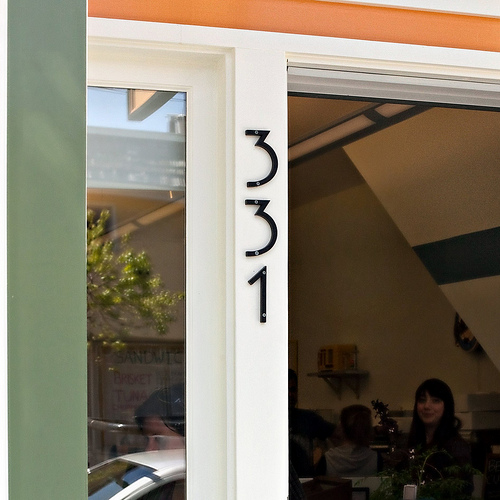 The newest addition to the ever-growing list of Bernal Heights culinary resources can be found at 331 Cortland, both the name and the address of a conglomeration of food-centric stalls in a single storefront. After longer-than-expected delays for construction and permitting — apparently, nobody in city hall knew quite how to handle a multi-unit setup under one roof — the six marketplace vendors held a soft opening today for their Bernal neighbors.
The newest addition to the ever-growing list of Bernal Heights culinary resources can be found at 331 Cortland, both the name and the address of a conglomeration of food-centric stalls in a single storefront. After longer-than-expected delays for construction and permitting — apparently, nobody in city hall knew quite how to handle a multi-unit setup under one roof — the six marketplace vendors held a soft opening today for their Bernal neighbors.
We stopped in around 3pm and found a good-sized crowd full of happy folks getting their afternoon snack on. Bernal Cutlery features Japanese whetstone knife sharpening, plus a beautiful assortment of knives both culinary and otherwise. El Porteño, a familiar vendor at many local farmers markets, carries their full line of sweet and savory Argentinian empanadas. Paulie’s Pickling sells pickles, of course, as well as a rotating selection of sandwiches and deli salads.
On the other side of the shop, Wholesome Bakery features vegan and low-glycemic treats and breads. ICHI Lucky Cat Deli, the new home of ICHI’s itinerant sushi-makers, offers nigiri, maki, and sashimi, as well as some specialty snacks (katsu-sando sliders, oh my!). In the front window, Della Terra Organics sells a pretty assortment of fresh produce from local farms. Each of the vendors will set their own hours, but the marketplace as a whole plans to be open 7am to 7pm every day.
It’s a plethora of options, and a welcome addition to the area. The new marketplace joins the small but quite comprehensive Good Life Grocery, the much-lauded Avedano’s Meats down the block, and newcomer Sandbox Bakery at the other end of the Cortland shopping district. You can stroll a few blocks and pick up pretty much everything you need for a picnic in Holly Park, or a home-made dinner. Surprising as it seems, once-sleepy Bernal could actually become food-lover’s shopping destination.
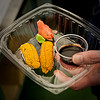
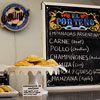

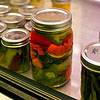
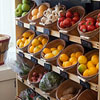
The Marketplace at 331 Cortland
331 Cortland Avenue (x Bennington)
San Francisco, CA 94110
@331Cortland on Twitter
ICHI Lucky Cat Deli
http://ichisushi.com
415-822-4024
@ICHIsushi on Twitter
El Porteño Empanadas
http://www.elportenosf.com
415-357-3621
@ElPorteno on Twitter
Paulie’s Pickling
http://www.pauliespickling.com
415-285-0800
@PauliesPickling on Twitter
Wholesome Bakery
http://www.wholesomebakery.com
415-343-5414
@wholesomebakery on Twitter
Bernal Cutlery
http://www.bernalcutlery.com
415-902-6531
@BernalCutlery on Twitter
Della Terra Organics
http://www.dtoproduce.com
Bernal, locavore, shopping
2 Comments »




Posted by Anita on 05.12.09 5:34 PM
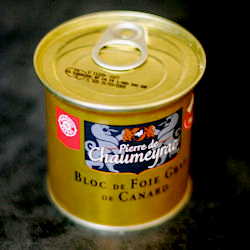 Bill Andronico
Bill Andronico
Andronico’s Markets Inc.
1109 Washington Avenue
Albany, CA 94706
Dear Mr. Andronico:
I have been a long-time shopper at your Irving Street store in San Francisco. Although I no longer purchase meat at the supermarket — preferring to buy my meat and eggs directly from farmers who make a point of their humane and ethical practices — I have always been very impressed by the knowledge and skill of your butchers in the past. Which is why I am stunned to read about your ill-informed, reactive policy regarding foie gras sales.
I don’t generally eat foie gras myself — I don’t care for its richness, nor its cost — but from rather extensive reading on the subject, I think it’s quite plausible that the “cruelty” of its production is overrated. On the other hand, I fully believe that standard, everyday conditions for commercial hens, pigs, cows, and other factory-farmed animals are grossly inhumane by any realistic measure.
If you and your company truly cared about animal welfare, you would stop selling battery-hen eggs and feedlot pork. Intensive factory farming is far more cruel — and thousands of times more pervasive — than the process of “force feeding” geese and ducks.
I suggest you do some additional homework about the realities of what goes into the meat, eggs, and dairy you sell before zeroing in on such an easy knee-jerk target. (The movie Food, Inc., which opens next month, might be a good starting point.) Otherwise, you run the risk of looking like a publicity-hungry hypocrite.
Bay Area, meat, shopping
9 Comments »




Posted by Anita on 11.15.08 11:46 PM
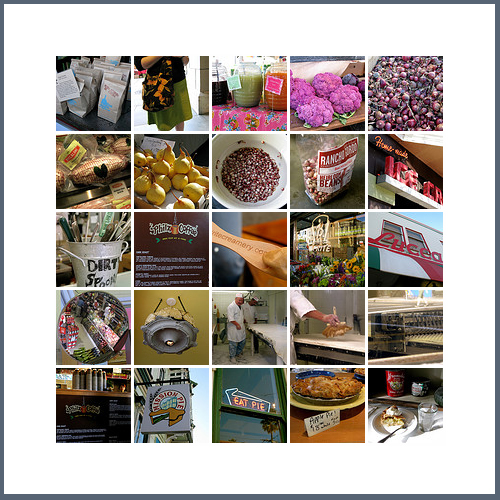
Oh, what fun we’re having with Laura, eating our way around the Ferry Plaza and The Mission from sunrise to sunset, then cooking up a storm for the first night of the Dark Days challenge. The three of us (with the dogs, naturally) sat up gabbing until almost midnight, telling stories and talking about… food, duh!
I promise a thorough recap later, but for now you can check out my Flickr set — plus Laura’s Flickr set and post on (not so) Urban Hennery — for a quick peek at our day.
Dark Days challenge, farmers markets, other blogs, shopping, The Mission
3 Comments »




Posted by Anita on 04.06.08 12:03 PM
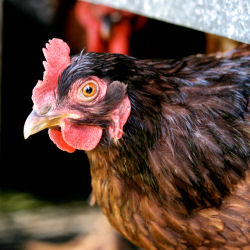 Before Niman Ranch started raising their herds on Iowa feedlots, their marketing materials bragged about “happy cows with ocean views”. Last Sunday, as we popped over the crest of Pierce Point Road and saw limitless green pasture dotted with black steers overlooking the deep blue waters of the Pacific, I gasped: It was exactly the scene that I’d held in my mind’s eye all these years. Only this land and these cattle belong to Marin Sun Farms, the ranch that supplies us with most of our eggs and meat.
Before Niman Ranch started raising their herds on Iowa feedlots, their marketing materials bragged about “happy cows with ocean views”. Last Sunday, as we popped over the crest of Pierce Point Road and saw limitless green pasture dotted with black steers overlooking the deep blue waters of the Pacific, I gasped: It was exactly the scene that I’d held in my mind’s eye all these years. Only this land and these cattle belong to Marin Sun Farms, the ranch that supplies us with most of our eggs and meat.
Even a week after our visit, I’m having a hard time expressing the depth of my awe for what David Evans is doing out on his Historic H Ranch, just 50 miles north of San Francisco. David’s family has farmed this same land since the early 1900s, although they were forced to sell it in the 1970s under the eminent domain act that created the Point Reyes National Seashore. The family leases back the land under what seems to be very tenuous circumstances: 5 year terms and government oversight of terribly minute details like the size of chicken flocks. Needless to say, it’s not the sort of sustainable permanence that makes this consumer particularly content.
Pronounced David’s way, the enterprise responsible for much of our weekly protein is properly known as “Marin Sun Farms” not “Marin Sun Farms.” Like his mentor Joel Salatin — who famously explained to Michael Pollan that he was a “grass farmer” — David takes pains to emphasize that his husbandry converts solar energy, by way of living pasture, into proteins that humans can digest. It’s half clever and half hokey, but undeniably true.
We started our tour overlooking the pasture where cows and calves ambled up and down spring-green hills, lolling in the lush grass or drinking from a large, clear pond. David talked at length about his ideology and his farming methods, explaining how herds — both chickens and cows — are moved to a different patch of land each week, preserving the pasture from over-grazing and enhancing the soil with their manure.
We peeked into a converted freight trailer turned chicken nursery, spying four gaggles of Easter-perfect chicks peeping around under heat lamps, pecking away at their feed. From there, we strolled down a wide lane to look in on David’s sister’s goat herd, busily clearing a scrubby yard where vegetables had been grown over the previous winter.
Beyond the goat yard, we saw two quonset hut-shaped structures on a distant hillside, our first glimpse of the farm’s egg-laying operation. Built of canvas-like material stretched over simple wood frames, these chicken houses open directly onto open pasture, without any physical barriers to any one of the chickens flying or wandering off. Apparently their social structure makes that unlikely; they’re much more apt to leave in the clutches of a predator, according to David. Perhaps half of the chickens roosted inside their homes, and the remainder scratched and pecked and flapped away outside in the open air. Glancing at the wide range of breeds, I suddenly understood the diversity of the colors and sizes of the eggs in our weekly dozen.
Many of us remarked with surprise that this egg-laying flock included a fairly large number of roosters, in addition to the laying hens. “I don’t do it so we can say the eggs are fertile,” said David, “But I know that I wouldn’t be happy in an environment without females, and I don’t think any of you ladies would be happy in a world without men.” Even as an unrepentant omnivore, it’s hard to wrap your brain around someone who makes his living selling meat treating his product with such humane regard.
Up the road a piece, we called on the broiler flocks, grown-up versions of the fuzzy peeps we’d seen pecking in the nursery. Penned in movable, mesh-covered yards — half in sun, half in shade — these birds were, quite frankly, the ugly ducklings of the farm. Where the laying hens are diverse and beautiful, Cornish Cross broilers look like the freaks of nature we’ve bred them to be. Sparsely feathered, dull around the eyes, and unbelievably gawky, these aren’t birds you feel too much sentiment toward. Still, they’re cared for with the same meticulous attention. They’re fed organic cracked grain, supplementing all the insects and grubs they can forage from their patch of pasture. At the end of the week, when they’ve cleared the pests and fertilized the land beneath their enclosures, their coops are canted up on a large dolly and rolled forward to a new stretch of green grass.
Sounds bucolic, and it certainly looks that way, too. Are things 100% perfect on this pastoral land? I’m sure they’re not. I would have been happier not knowing that Marin Sun Farms broiler chicks are fed imported Chinese soy until they’re old enough to digest corn and grubs. Or that David feels that heirloom birds are just too expensive (twice the cost of the already pricey hybrids he brings to market, he says) and don’t taste any better than the ugly mutants. Or that most of the calves born at his parents’ H Ranch operation are destined for life on the feedlots of the Midwest, because there simply isn’t enough demand for pasture-raised beef. But despite all of the things that I wish they were doing more-perfectly, the simple fact is that I am in awe of the 99% that Marin Sun Farms is doing exactly right.
Rounding our way back to the main barn, David stopped to talk about the on-farm ‘processing’ — that is, slaughtering — that farmers are, thankfully, still allowed to do for their own poultry. As he explained that the next part of the tour was occasionally more than some visitors had bargained for, I finally focused beyond David’s shoulder, at last noticing a critical part of the farm that had previously escaped my notice. Having read Michael Pollan’s description of the Polyface Farms “abattoir without walls,” I knew enough to recognize it: The metal cones where chickens are killed and bled out, the plucking machine with its hundred rubber ‘fingers’, the well-worn worktables, the buckets for the blood and guts that get turned into the compost pile to amend the land. No roof, no walls; everything open to the sun and the wind, nature’s original sanitizers. It was all right there… right there for anyone to see, to understand.
I knew well enough we wouldn’t see any chickens slaughtered that Sunday — it happens on Thursdays, anyway, and the oldest of this season’s broilers were still a week from market, merrily clucking away in the pasture. Nothing had been slaughtered here since the old roosters and hens had come to market last winter; the killing place smelled of nothing but the hillside around us. And yet, it had the undeniable air of purpose. I won’t insult you by saying it felt holy, but I do know that there was no nervous laughter, no chatter, no wandering off to investigate something more interesting around the corner. Every one of us on that tour, kids included, was completely present there, standing inside the boundaries of the place where animals became food: The place where each bird experiences what David calls its “one bad day” on the farm.
—-
When the tour was over, we caravaned back over the road to Route 1. David treated everyone to lunch at the Marin Sun Farms Butcher Shop, a bountiful spread of Della Fattoria bread, the farm’s own rib eye and roast goat, bowlsful of aioli and horseradish cream and salsa verde, and buckets of German-style potato salad with flecked with rich bacon.
But the best part of the lunch was the beverage: David brought out “a gift” — which he couldn’t legally sell to us — of a few gallons of raw milk “just hours out of the cow” in oversized Mason jars. I’d shied away from buying raw milk at the stores, imagining that it would taste grassy or gamey. But oh, lord, what I’d been missing! It just tasted more milk-y, like a better version of the best milk you’ve ever had. Nuances of flavor, texture, and color are apparent even to the most casual observer.
Needless to say, we bought a quart of Claravale raw milk this Saturday, and I don’t expect to go back to the sterile, flat stuff anytime soon. Nor do I expect I will soon forget the windy spring morning when I looked my supper in the eye and made peace with my place on this sustainable food chain.

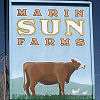
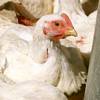
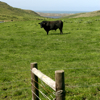
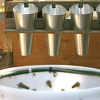
Marin Sun Farms
10905 Shoreline Highway
Point Reyes Station, CA 94956
415-663-8997
Meat CSA memberships available starting at $270 for a 6-month session
Retail sales available at the Point Reyes butcher shop, Saturday Ferry Plaza Farmers Market and Sunday San Rafael Civic Center Farmers Market
Next farm tour: May 18, 2008
Adults $30, Kids $10
(Pre-registration is mandatory)
Dark Days challenge, farmers markets, farms & farmers, locavore, meat, shopping
13 Comments »




Posted by Anita on 02.24.08 2:21 PM
 We’ve talked a lot about our Dark Days Challenge dinners, and even occasionally mention our lunchtime trials, but — aside from our “free-range” egg dilemma — we’ve rarely made a peep about breakfast. The truth of the matter is we’re in a bit of a rut: Nearly every morning, Cameron eats an over-easy egg and a slice of Acme toast with Spring Hill farmstead butter. Not such a fan of the usual breakfast fare, morning often finds me dipping into leftovers, cannibalizing my lunch, or scrounging some other non-breakfasty breakfast.
We’ve talked a lot about our Dark Days Challenge dinners, and even occasionally mention our lunchtime trials, but — aside from our “free-range” egg dilemma — we’ve rarely made a peep about breakfast. The truth of the matter is we’re in a bit of a rut: Nearly every morning, Cameron eats an over-easy egg and a slice of Acme toast with Spring Hill farmstead butter. Not such a fan of the usual breakfast fare, morning often finds me dipping into leftovers, cannibalizing my lunch, or scrounging some other non-breakfasty breakfast.
But when the weekends roll around, it’s big-breakfast time for both of us. Every Saturday, we head to the Primavera stand at the Ferry Plaza Farmers’ Market at the start of our shopping rounds. We’re so predictable that David and Paulette know us by name, tease us when we’re bleary-eyed, and generally treat us like the regulars we are. Some days we split a single order of chilaquiles, but more often — especially if there’s something else on the changing menu that catches our eye, like fish tacos, perhaps, or tacos al pastor — we’ll each get our own plate and share. Primavera’s tortillas and chips aren’t made from local corn, but they do manufacture both items in Napa, and purchase their eggs and produce from local farms. Judged by volume, our Saturday breakfasts probably don’t quite make it to the 90%-local mark, but we’re content with understanding exactly where our food is coming from, and knowing that we’re directly supporting such a fabulous crew.
We often stay up late on Saturday nights, so Sunday breakfast is more of a brunch-time affair. Sometimes we’ll brown some homemade pork sausage and Cameron will whip up biscuits and gravy with scrambled eggs. Other times we’ll simply fry up some local bacon — we alternate between Fatted Calf and Range Brothers — and serve it alongside two of Cameron’s perfect basted eggs and a slice of Acme toast topped with June Taylor preserves or local honey. We rarely plan these Sunday meals in advance, and yet they’re always wonderful.
During the first part of the month, we had two of my favorite brunches of all time: a post-porchetta batch of hash with poached eggs and buttery toast, and a plate of custardy French toast made from leftover baguette slices (we froze two bags full after the cocktail party!) alongside Range Brothers sausage. With the exception of maple syrup, and the flour in the locally made bread, everything on our table on both mornings was 100% local. And 100% fabulous.
For the most part, we stuck with old favorites and tried-and-true options for lunches and dinners in the first part of the month; even our Valentine’s Day dinner was a simple grilled steak with creamed spinach and roasted potatoes, with ice-cream sundaes for dessert. We did have one out-of-the-ordinary supper: A picnic in a cozy downtown hotel room. Much as I’d love to tell you that we planned a romantic escape, the truth is that the overgrown frat-boy who lives in the house next door decided to have (yet another) all-night party, and we had to evacuate.
While Cameron packed up the dogs and our overnight bag, I headed to a local supermarket for makeshift meal provisions. The locavore-friendly pickings at the Bristol Farms around the corner from my office are pretty slim, but I did manage to score a crusty loaf of Artisan bread, some respectable sopressatta from a outfit called Ticino (a second-label brand from local mega-brand Columbus, it turns out), and a couple of nice local cheeses. A quick stop at CocoaBella turned up just two locally made treats: peanut butterflies and salt caramels from Charles Chocolates — a sweet ending to an otherwise hectic evening.


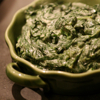
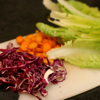

Dark Days Ticker — February 1 to 14
– Dark Days meals at home: 8 dinners, 2 brunches, most breakfasts
– Locavore dining-out: Range
– New recipes: Chard gratin, Coq au vin
– Old faves: porchetta, pork hash, shaved fennel salad, Clearman’s red cabbage slaw
– Freezer fodder: Rigatoni Bolognese, Cameron’s chicken soup
New local items in the pantry:
– Capellino spinach-ricotta ravioli (San Francisco — 5 miles)
– Charles Chocolates (Emeryville — 13 miles)
– Ticino sopressata (Hayward — 35 miles)
– Marin Sun Farms range roosters & stewing hens (Point Reyes Station — 43 miles)
– Artisan Bakers sweet batard (Sonoma — 47 miles)
– Barbara’s Natural potato chips (Petaluma — 51 miles)
– Rancho Gordo chiles de arbol (Napa — 51 miles)
– Marin Roots Farm mâche/lambs lettuce (Petaluma — 52 miles)
– Fiscalini Farmstead ‘San Joaquin Gold’ grating cheese (Modesto — 87 miles)
breakfast, Dark Days challenge, locavore, shopping
8 Comments »




Posted by Anita on 02.14.08 12:03 AM
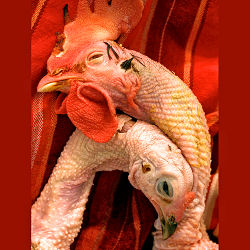 Have I mentioned lately how much I love the farmers who keep us fed? Even when I’ve done something utterly short-sighted, they managed to swoop in and save me from my own culinary stupidity.
Have I mentioned lately how much I love the farmers who keep us fed? Even when I’ve done something utterly short-sighted, they managed to swoop in and save me from my own culinary stupidity.
Last week, Cameron came up from the basement and announced that somehow we’d run out of chicken stock. “That’s impossible,” I replied. “We had gallons…” A quick trip down the stairs showed that he was right. GULP!
Given that our source of pastured, local chickens dried up before Thanksgiving and that I didn’t really do anything to prepare for this eventuality other than making my usual batches when the bone-bag filled up, I guess I am lucky to have made it this far into winter without running dry. But how could we survive months without a local source of one of our most necessary staples?
After three grocery stops, I finally managed to find local, organic chicken backs. Unfortunately, the Rosie chicken parts that Whole Foods carries come from factory organic farms — they’re local, technically, and ‘free range’, technically, but they’re not really my idea of humane, ethical meat. Unless I wanted to go without stock until spring, I was going to have to choose the lesser of various evils. I went home chickenless and annoyed at my lack of planning.
Two days later, whatever deity watches over locavores and other fools swooped in to save my bacon:
From: Cara, Marin Sun Farms
Subj: Range Hens & Roosters
Range hens and range roosters will be offered this weekend at our Farmer’s Markets and Butcher Shop in Point Reyes Station on a first come first serve basis.
I could hardly believe my eyes: pastured chickens, in February? We’ll take two, please. They weren’t cheap — one rooster and one hen tapped out our protein budget for the week (and then some). But they were there, and that’s all that mattered to me and the other folks who swarmed the stand as the market opened.
It turns out that these sturdy birds were no spring chickens [groan!]. Happy by-products of Marin Sun Farms’ egg production, they’re easily double the size of the birds we buy in the spring and summer.
If you think you’re smugly immune to the grim realities of chicken butchery after a summer of dainty heads and tiny feet, you’ve got another thing coming when your supper greets you with an open-eyed stare. And cutting big birds into parts is no trauma-free event, either. Like most other creatures, chickens’ bones and tendons firm up as they mature. The simple shears-and-boning-knife operation required to part out a 3-month-old fryer is a walk in the park compared with the hatchet-job required to take apart a full-grown rooster — and I have the torn-up hands to prove it.
Even if these birds hadn’t been freakishly large, their long, narrow breasts would be a dead giveaway. Barely more than one serving of white meat per bird, these bony chests make an almost-comical sight paired with long, rangy legs. “They look like chickens that tried out for the basketball team,” quipped Cameron.
Mature fowl are best cooked low and slow; one of the MSF farmers was telling folks at the stand that he’d made an exploratory batch of fried chicken, just to see, and… well, no surprise, he didn’t recommend anything but the soup pot or a long, slow stew for any of these tough old birds. (See how many American idioms come from our agricultural roots?)
Of course, any grandma will tell you that modern factory chicken doesn’t taste like it did in the olden days, and much of that has to do with the fact that today’s chickens are slaughtered well before they’re adolescent, much less geriatric. As early as the 1960s, full-fledged stewing chickens were hard enough to come by that even Julia was calling for a measly 2-1/2 to 3-pound fryer for her coq au vin.
Thankfully, we found a lovingly thorough recipe — avec un vrai coq — in our new copy of the River Cottage Meat Book, Hugh Fearnley-Whittingstall‘s ode to sustainable eating in all its carnivorous glory. “They might be scrawny and … on the tough side” says our man Hugh, “But with a diet comprising largely natural forage, by god they’d be tasty.”
Not that I’d ever gainsay a meat maven like Mister F-W, but old-man rooster was definitely an acquired taste, even if you’re used to the “more-chickeny” flavors of pastured meat. Don’t get me wrong: The flavor it lent to the sauce was truly unparallelled — an unctuous, meaty taste that felt in all ways more like beef stew than anything poultry based. As for the meat itself, I liked it when I ate it in the small pieces that flecked the sauce, but the larger chunks were a tad too gamey for my girly palate. Cameron, however, gobbled his bowl while making little moaning noises, so chacun à son goût. For the leftovers, I shredded the meat and put it back in the sauce; served over pasta like a ragu, the flavor was perfect.
Oh, and the backs, wings, feet, heads, and other sundry bits made 12 glorious quarts of golden stock. Our freezer is chock-full of delicious homemade goodness once more. And if that’s not true love, baby, I don’t know what is.




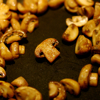
Coq au Vin
— adapted from the River Cottage Meat Book
1 stewing chicken, ideally a farmyard rooster*
1/4 cup butter
1T olive oil
8 ounces pancetta or bacon, cut into large chunks
8 ounces onions, cut into quarters
1/3 cup all-purpose flour, seasoned with salt and pepper
4 oz brandy
2 cups red wine
2 cups chicken stock
bouquet garni of parsley stalks, bay leaf, and thyme
4 celery stalks, cut into 1-1/2-inch lengths
4 garlic cloves, smashed
2 cups canned chopped tomatoes
—
6 to 8 carrots, cut into 1-1/2-inch pieces
1/2 pound white button mushrooms, halved or quartered depending on size
4 to 8 ounces small onions (such as cippolini or pearl), peeled and trimmed
Preheat the oven to 250°F. Cut the chicken into 4 serving pieces, reserving the neck, back, and wingtips (and feet and head, if available) for stock. Heat the butter and oil in a large ovenproof casserole. Fry the bacon pieces in the butter/oil until browned, and remove to a plate with a slotted spoon. Lightly brown the onions in the same pan, and likewise remove them to the plate.
In a paper bag, shake the chicken pieces with the seasoned flour until coated, tapping them against the side of the bag to remove any excess. Brown the dredged chicken in the bacon-butter-oil, working in batches if necessary so as not to crowd the pan, and turning to brown all sides properly. If you’ve worked in batches, return all the chicken parts to the casserole. Pour the brandy over the chicken and (very, very carefully) flame it with a long-handled match. When the flames die down, remove the chicken to the plate with the onions and bacon.
Add the red wine to the casserole, scraping the bottom and sides of the pan to remove any stuck-on bits. Add the stock to the pan and heat to a simmer. Then return the bacon, onions, and chicken to the pan along with the herbs, celery, garlic, and tomatoes. Bring to a gentle simmer. Cover and cook in the oven for 2 to 2-1/2 hours (more like 1-1/2 hours for a younger chicken) until the meat is completely tender.
When you’re within a half-hour of serving time, saute the mushrooms in a bit of olive oil. Please resist the temptation to salt them until they are browned and delicious — you will get a much firmer, tastier mushroom. Meanwhile, in a small frying pan, gently cook the carrots and onions in a shallow layer of water, turning them occasionally and removing them from the pan when they’re just cooked through.
When the chicken is ready, check the consistency of the sauce. If you have a very tight-fitting casserole lid, and/or a wimpy chicken, you may need to reduce the liquid by as much as half of its volume. (Leave the chicken and vegetables in the covered casserole, and reduce the sauce in a separate pan.) Once your pan sauce is thick enough to coat the back of a spoon, put everything together — chicken, vegetables, mushrooms, and sauce — and bring back just to a gentle simmer.
Adjust seasonings to taste, and serve with your favorite mashed potatoes or herbed new potatoes.
* If no roosters are available, HF-W recommends substituting the legs, wings, neck, and giblets of a good free-range turkey, leaving the breast to be roasted another day.
Dark Days challenge, locavore, recipes, shopping
26 Comments »




Posted by Anita on 01.25.08 10:34 PM
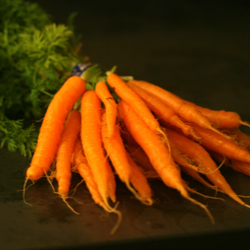 We haven’t gone in much for New Year’s resolutions this year, but we are making a few small changes. As part of our Dark Days Challenge (and as a side effect of finally finishing reading Omnivore’s Dilemma, two years behind the curve) we’re moving more of our food-budget dollars around. We’d already dabbled a bit in acclimating our palates to grass-fed beef, and we’re going to get more serious about it this coming year.
We haven’t gone in much for New Year’s resolutions this year, but we are making a few small changes. As part of our Dark Days Challenge (and as a side effect of finally finishing reading Omnivore’s Dilemma, two years behind the curve) we’re moving more of our food-budget dollars around. We’d already dabbled a bit in acclimating our palates to grass-fed beef, and we’re going to get more serious about it this coming year.
But possibly the largest change — one that has an effect on something we eat literally every day — is making the switch to pastured eggs. As I mentioned in the comments to our last Dark Days post, I finally decided that spending the extra cash for ethically raised eggs was really not going to put a huge dent in the food budget. But man, $7 a dozen feels extravagant when you’ve been spending $2.25 for quasi-organic eggs.
Which brings me to one of my first food discoveries of the new year: Just because you buy your eggs from a joke-cracking fella at the Ferry Plaza market doesn’t mean they’re ethically raised. (If you get your eggs from Judy’s Family Farm or any of the other eggs at the stand across from June Taylor, do yourself a favor and click that link.) Needless to say, I was pretty pissed off to discover that I’d been duped by what Michael Pollan might call “farmers market pastoral.” It took a dose of righteous anger to open my eyes: A $5-per-week premium isn’t outrageous. It’s a tiny fraction of our food budget, and a drop in the bucket compared to the cost buying of ethically farmed meat.
 With that little surprise under my belt, I reluctantly started digging deeper into the true origins of other items that I’d previously assumed were sustainably produced. Much to my pleasant surprise, Clover Organic and a number of other brands I suspected might be greenwashing were entirely on the level. (I’m not sure whether I was more shocked by my egg supplier’s betrayal or the honesty of one of the area’s largest dairies.)
With that little surprise under my belt, I reluctantly started digging deeper into the true origins of other items that I’d previously assumed were sustainably produced. Much to my pleasant surprise, Clover Organic and a number of other brands I suspected might be greenwashing were entirely on the level. (I’m not sure whether I was more shocked by my egg supplier’s betrayal or the honesty of one of the area’s largest dairies.)
But back to the sunny side: Putting together Dark Days meals continue to feel far too easy. Our summer of canning, salting, freezing, and otherwise preserving the harvest is paying off in spades; sometimes dinner’s as simple as opening the freezer, thawing a bag of protein, and heating up a starch and a farmers market vegetable to go alongside.
We’ve also managed to add a number of new local items to our roster of ingredients. In the first half of the month, we sourced Liberty duck from Sonoma County Poultry (Penngrove – 48 miles); Giusto’s flour and baking soda (South San Francisco – 8 miles), and of course those Eatwell Farm pastured eggs (Dixon – 67 miles).

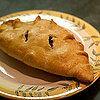

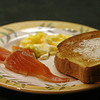

Dark Days Ticker — January 1-15
– Dark Days dinners: 7 (out of 15)
– New recipes: Duck burgers, country-fried steak, Cornish pasties
– Old faves: One-day cassoulet (leftovers)
– Freezer fodder: Chile verde tacos; gravlax; linguine Bolognese; fusilli marinara
Dark Days challenge, locavore, shopping
13 Comments »




Posted by Anita on 11.20.07 11:48 AM
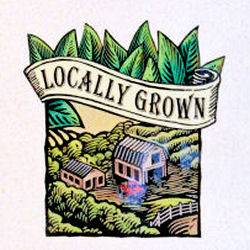 In lieu of my usual meal recap, this week’s Dark Days post touches on the retail side of the equation. Despite our weekend in Los Angeles — which obviously kept us away from our beloved farmers market — and Cameron’s four-day business trip, I managed a number of 100-mile meals.
In lieu of my usual meal recap, this week’s Dark Days post touches on the retail side of the equation. Despite our weekend in Los Angeles — which obviously kept us away from our beloved farmers market — and Cameron’s four-day business trip, I managed a number of 100-mile meals.
I’m sure you’re not particularly interested in the details thrown-together dinners of lazy mac & cheese, wintertime BLTs (with tomato bourbon jam as the “T”), mushroom omelets, or another rehash of Friday spaghetti night… but if you’re feeling left out, I’ve put a few photos on Flickr.
——
As good as we Bay Area locavores have it when it comes to restaurants and farmers markets, the notion of shopping with local products in mind seems to have gained very little traction in the retail world. Awareness of the benefits of locally grown and locally produced foods is spreading rather slowly beyond the rarefied world of the farmers-market set. It’s a difference that’s become more obvious as we seek out a wider variety of local ingredients as part of the Dark Days Challenge.
As I mentioned last month, Whole Foods recently made a much-publicized commitment to support local farms and purveyors. Rather than funneling all orders through a regional warehouse (where demands might be too great for any small farmer), Whole Foods produce managers can now literally buy produce off their loading docks from the people who raise it. Our local Whole Foods stores are following through on the consumer side, with little laminated signs touting the county of origin of most fruits and vegetables. Although the produce is far from exclusively local — a good deal still comes from the southern hemisphere — at least the labels allow consumers to make an educated choice.
Better yet, Whole Foods’ signage has been spreading beyond the boundaries of the produce section. Locally made cheeses are tagged at the service counter; locally produced pastas and sauces are flagged in the deli case, and locally sourced milk and butters get their due in the dairy aisle. PR spin or no, it’s an invaluable resource for those of us trying to reduce our food-footprint without turning into obsessive research nuts.
Even more amazingly, I noticed similar signs dotting the shelves at local supermarket chain Mollie Stone’s California Street location. Placed by an organization called Eat Local SF, these ‘shelf talkers’ are a little more generic than those at Whole Foods — they simply say “eat local”, with no point of origin listed. They’re also a bit less exclusive: Any prepared or processed food made within 250 miles is fair game, regardless of where the ingredients were sourced. (I also noticed a tag under olives bottled by a Southern California company with ‘Napa’ in its name, which were clearly labeled “Product of Spain”.)
But still, it’s baby steps in the right direction, and a stunning turnaround: The same chain didn’t even bother to respond last spring when I wrote them to explain why I was taking my business elsewhere (their employees couldn’t provide information on where their food was sourced). They may not be stocking their shelves any differently than in the past, but this one small bit of communication is making a visible impact on my customer satisfaction.
 If a mainstream chain like Mollie Stone’s can improve, why not the little guys, the ones who painstakingly cultivate an aura of hippie chic? Our neighborhood market — a crunchy outpost called Good Life Grocery — features a decent produce section given the store’s diminutive size. But on a recent trip, we spied exactly one tag from a local farm, and not a single store-placed mention of distances or purveyors. The new-ish Canyon Market, a similar shop over the hill in Glen Park, is similarly bereft of locavore-friendly signage. Which begs the question: When your produce section includes just a few dozen items, would it really be a lot of extra work to let folks know where their food’s grown?
If a mainstream chain like Mollie Stone’s can improve, why not the little guys, the ones who painstakingly cultivate an aura of hippie chic? Our neighborhood market — a crunchy outpost called Good Life Grocery — features a decent produce section given the store’s diminutive size. But on a recent trip, we spied exactly one tag from a local farm, and not a single store-placed mention of distances or purveyors. The new-ish Canyon Market, a similar shop over the hill in Glen Park, is similarly bereft of locavore-friendly signage. Which begs the question: When your produce section includes just a few dozen items, would it really be a lot of extra work to let folks know where their food’s grown?
My current benchmark for locavore signage is Rainbow Grocery, a SOLE shopper’s paradise. Their produce bins sport detailed signs outlining each product’s farming methods, organic certification authority, farm name, and place of origin. Their bulk-foods section includes information about not just the origin and ownership of local products, but the milling location of dry goods like flours and meals (most of which are sent out of state for processing, alas). An entire shelf in their justly famed cheese case is devoted strictly to local products, and a detailed list on their site outlines distances, dairies, and varieties stocked. Even their vast herb, spice, and tea bins are stocked primarily with products harvested in Washington, Oregon, and the California coast.
In time, as customers demand it, perhaps we’ll see the locavore focus move more deeply into the mainstream, much like organic vegetables did over the last decade. In the meantime, we’ll direct our food dollars toward the farmers market, direct-supplier shops like Prather Ranch and Cowgirl Creamery, and the handful of retail outlets that support the choices we’re making.
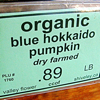

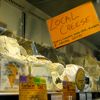

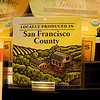
Whole Foods, Potrero Hill
750 Rhode Island Street (x 17th Street)
San Francisco CA 94107
415.552.1155
Mollie Stone’s Market, Pacific Heights
2435 California Street (x Fillmore Street)
San Francisco, CA 94115
415.567.4902
Good Life Grocery, Bernal Heights
448 Cortland Avenue (x Andover Street)
San Francisco, CA 94110
415.648.3221
Canyon Market, Glen Park
2815 Diamond Street (x Bosworth)
San Francisco, CA 94131
415.586.9999
Rainbow Grocery Cooperative
1745 Folsom Street (x Division/13th)
San Francisco, CA 94103
415.863.0620
locavore, shopping
8 Comments »




Posted by Anita on 09.06.07 12:02 PM
 Sure, sure… we’ve all heard the swooning coming from the assembled masses lining up outside Bi-Rite Creamery. (And yes, we’re in awe of their salt-caramel ice cream, just like everyone else.) But waaayyyy down at the other end of The Mission, there’s another ice-cream shop that’s packing them in every night, just like they have since the kids in line sported white bobby socks and greased hair.
Sure, sure… we’ve all heard the swooning coming from the assembled masses lining up outside Bi-Rite Creamery. (And yes, we’re in awe of their salt-caramel ice cream, just like everyone else.) But waaayyyy down at the other end of The Mission, there’s another ice-cream shop that’s packing them in every night, just like they have since the kids in line sported white bobby socks and greased hair.
Although the days when Mitchell’s used milk from its own dairy farm are long gone, each flavor is still made on the premises in small-batch freezers. More than 50 state-fair ribbons and medals on the wall tell the story of the family’s commitment to quality.
You won’t find any honey-lavender or soy-chai scoops here, but that doesn’t mean that Mitchell’s doesn’t get its gourmet groove on. The shop’s biggest claim to fame may be its roster of tropical flavors, sporting tongue-twister names like langka, macapuno, and lucuma, alongside a longer list of ‘standard’ (but still interesting) tastes. Reading the menu’s like a trip around the globe: Thai tea, Mexican chocolate, and New York Cherry are just three options. Feeling cocktailian? Rum raisin, Kahlua, and mojito might do the trick. A set of flavors rotates seasonally; peach holds court today, but pumpkin can’t be far off.
Go ahead, take a number. You’ve got plenty of time to decide…
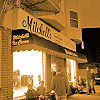

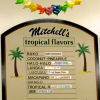
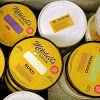

Mitchell’s Ice Cream
688 San Jose Avenue (at 29th)
San Francisco, CA 94110
415 648-2300
dessert, locavore, shopping, The Mission
9 Comments »




Posted by Anita on 06.04.07 12:14 PM
 It may have escaped your notice — especially if you’re reading the blog through an RSS reader — that we’ve added a new tab on Married… with Dinner. Ladies and gentlemen, I present you with the Bookshelf.
It may have escaped your notice — especially if you’re reading the blog through an RSS reader — that we’ve added a new tab on Married… with Dinner. Ladies and gentlemen, I present you with the Bookshelf.
Pretty snazzy, eh?
The default page shows all of the books we’ve mentioned on the site, with a link to their Amazon pages for more information. We’ve also built sub-pages that show our favorite books (those that have earned a slot on the bookshelf cubbies in the new kitchen lab-shelves) and for our entire collection.
Our primary motivation in building out the Bookshelf was a desire to have a handy place to link when we mention cookbooks on our site. And, you know, to let you snoop through our bookshelves without having to drop by the house on some pretense or other.
Full disclosure: If you start your Amazon shopping — for these books or any other products — from our site, we earn a small commission. (You don’t pay anything extra, but you get to support us anyway. How cool is that?)
cookbooks, shopping
Comments Off on Bookshelf browsing




 The newest addition to the ever-growing list of Bernal Heights culinary resources can be found at 331 Cortland, both the name and the address of a conglomeration of food-centric stalls in a single storefront. After longer-than-expected delays for construction and permitting — apparently, nobody in city hall knew quite how to handle a multi-unit setup under one roof — the six marketplace vendors held a soft opening today for their Bernal neighbors.
The newest addition to the ever-growing list of Bernal Heights culinary resources can be found at 331 Cortland, both the name and the address of a conglomeration of food-centric stalls in a single storefront. After longer-than-expected delays for construction and permitting — apparently, nobody in city hall knew quite how to handle a multi-unit setup under one roof — the six marketplace vendors held a soft opening today for their Bernal neighbors.








 Bill Andronico
Bill Andronico































 Sure, sure… we’ve all heard the
Sure, sure… we’ve all heard the 




